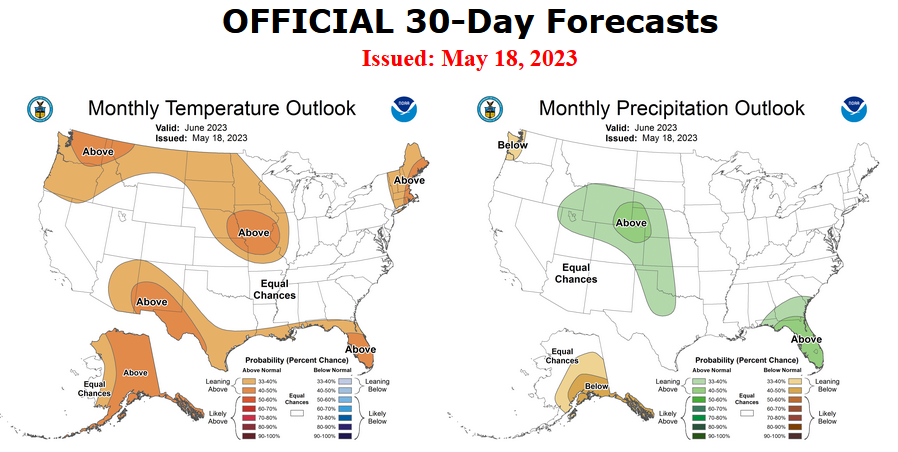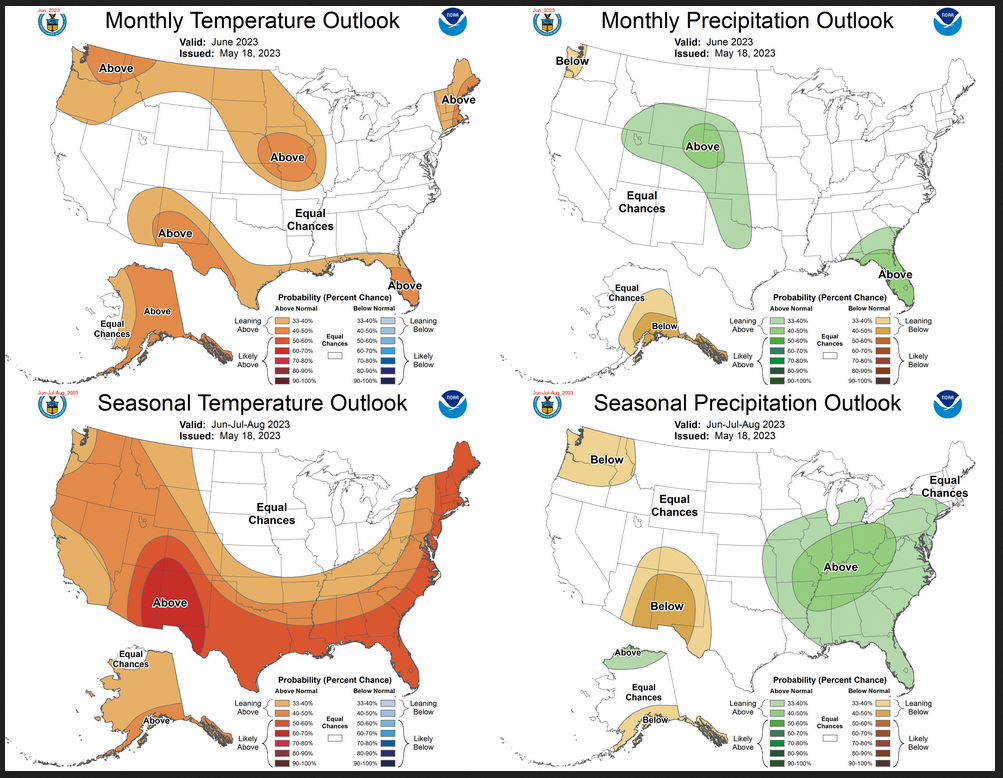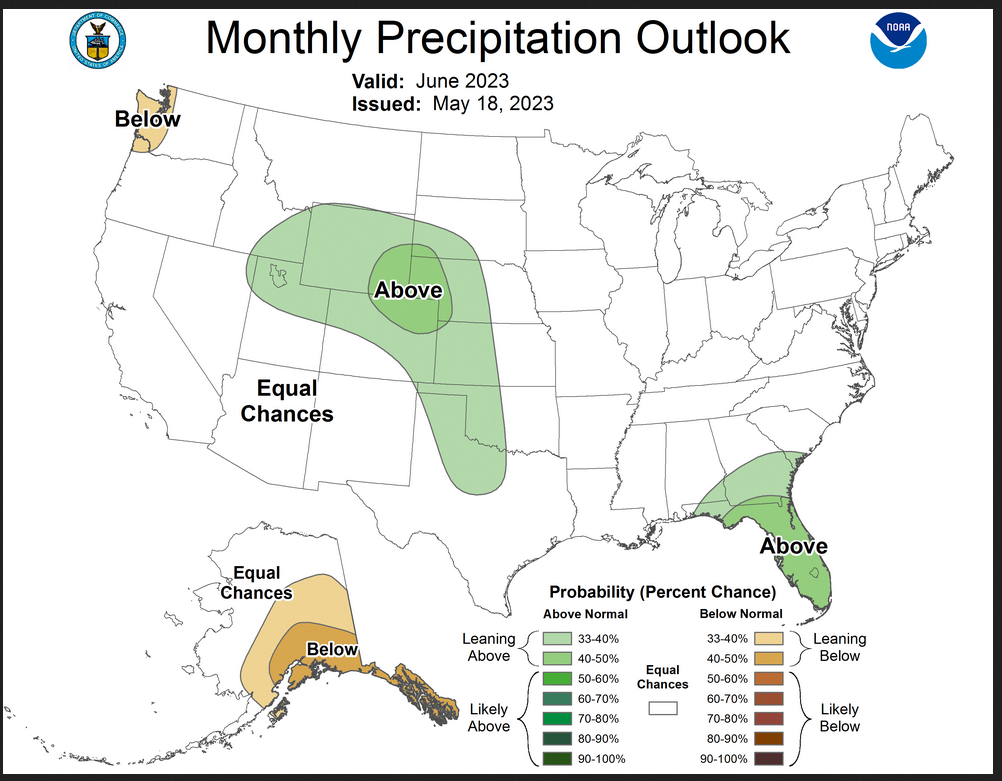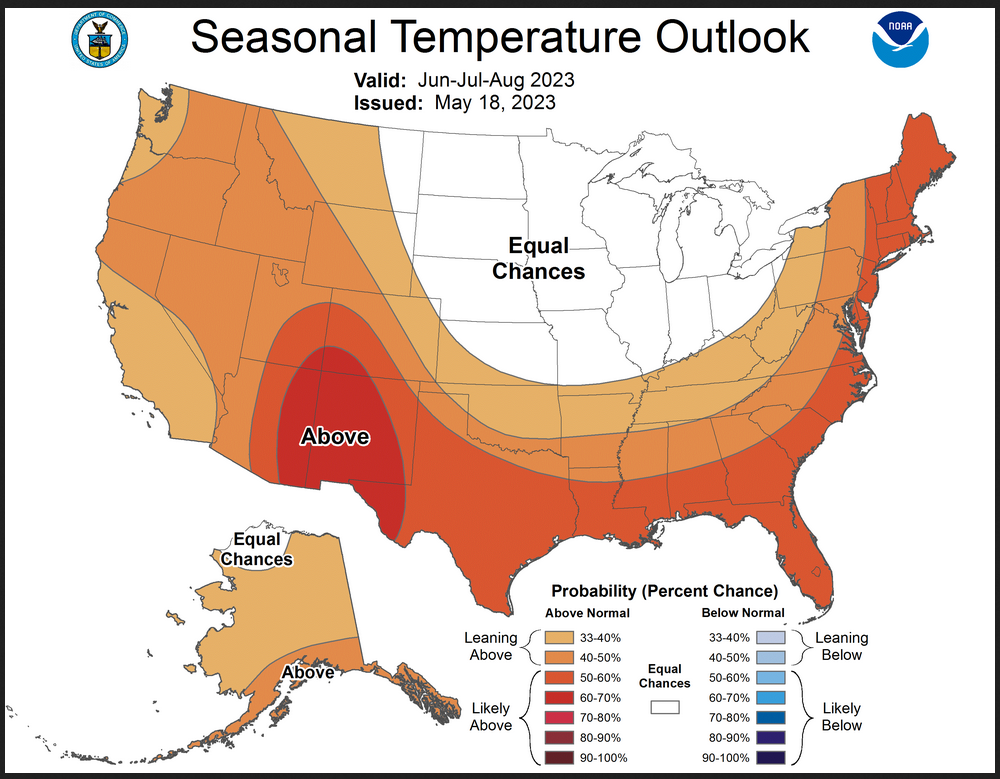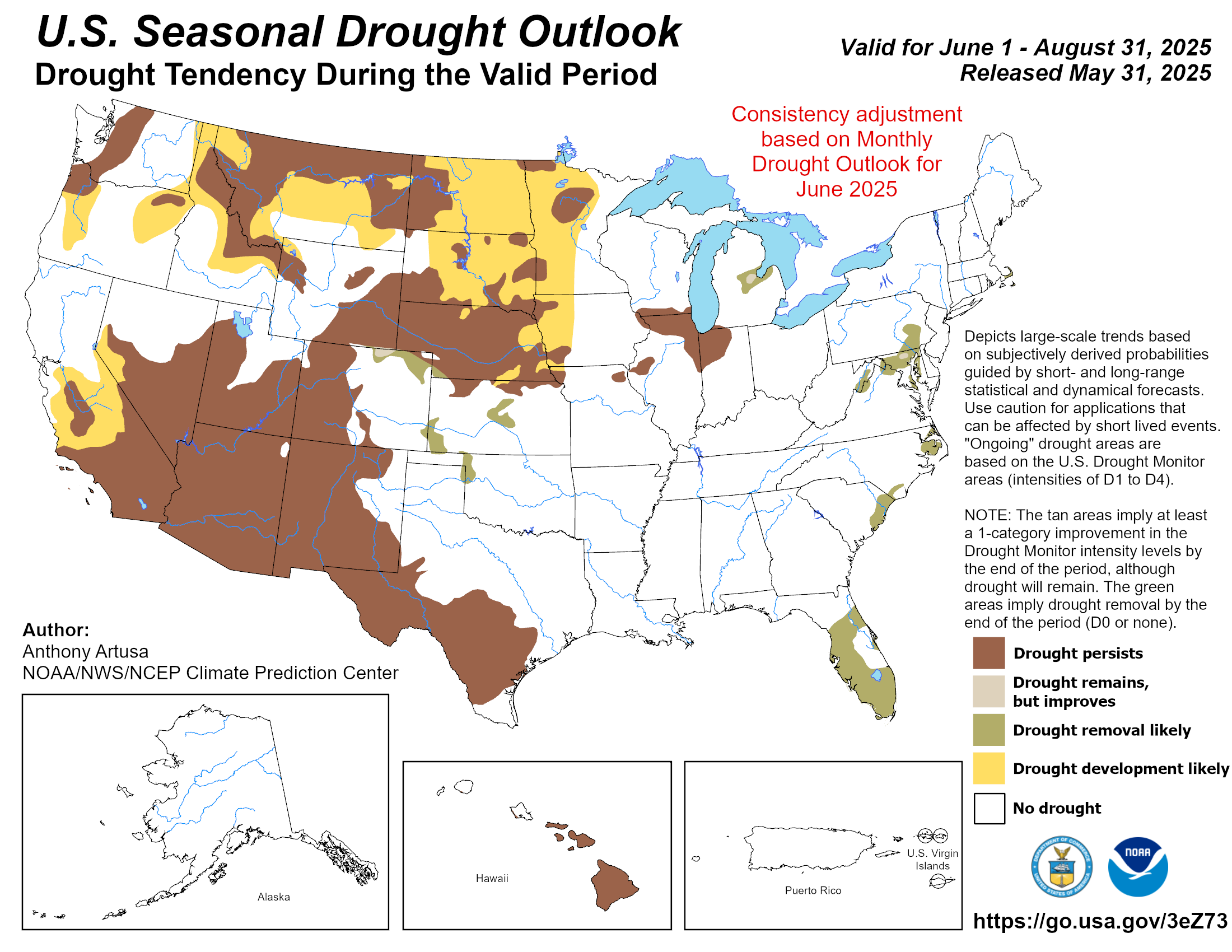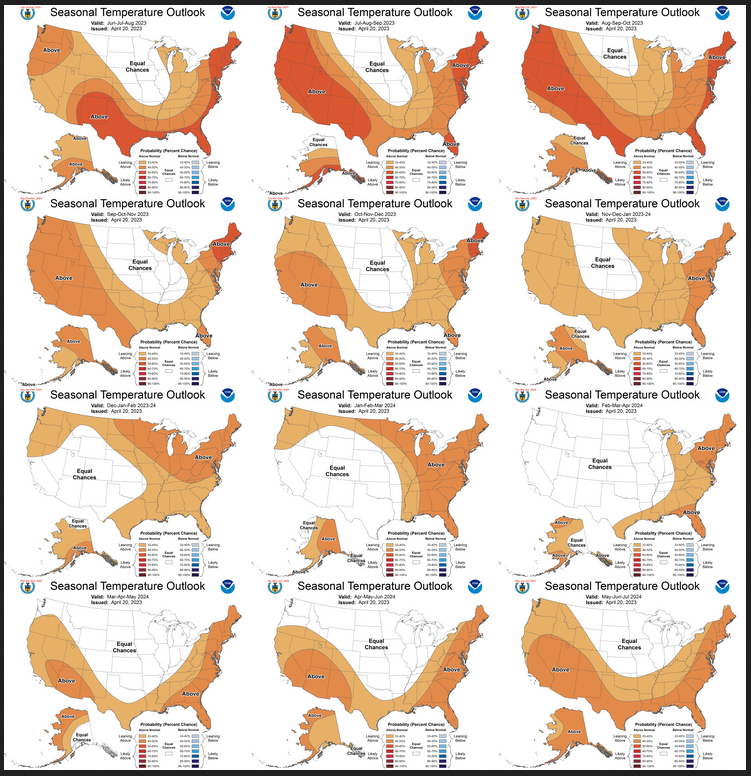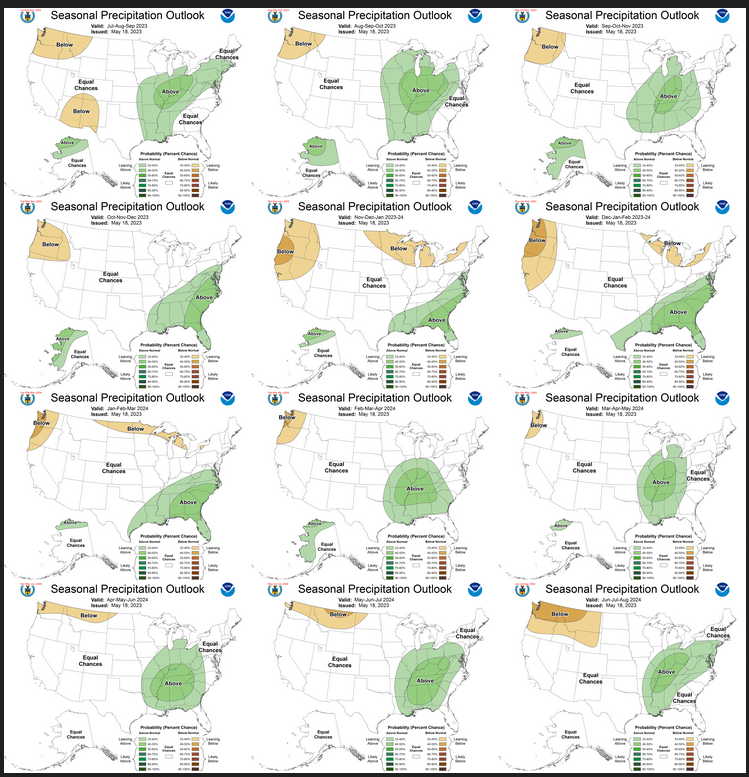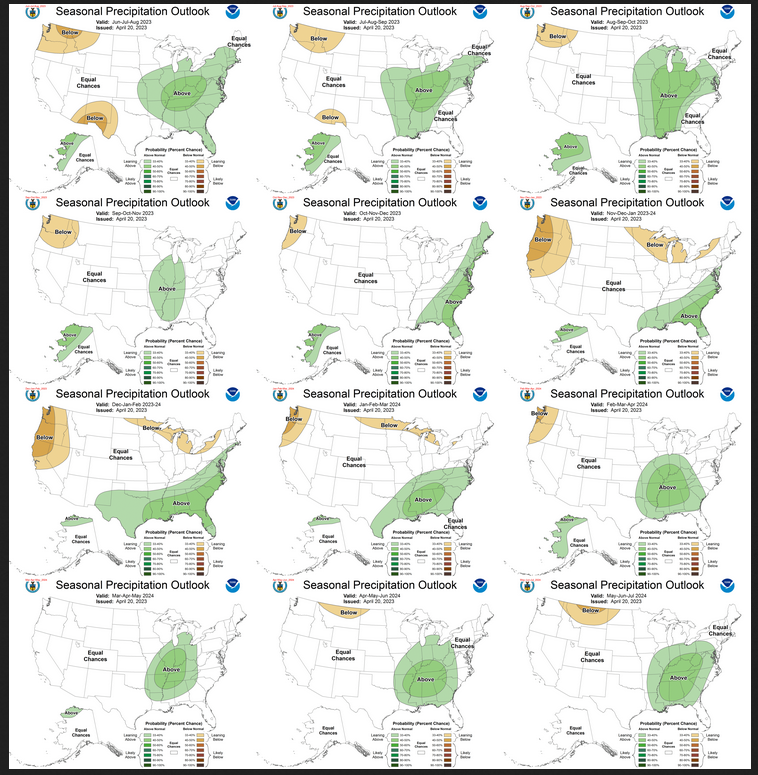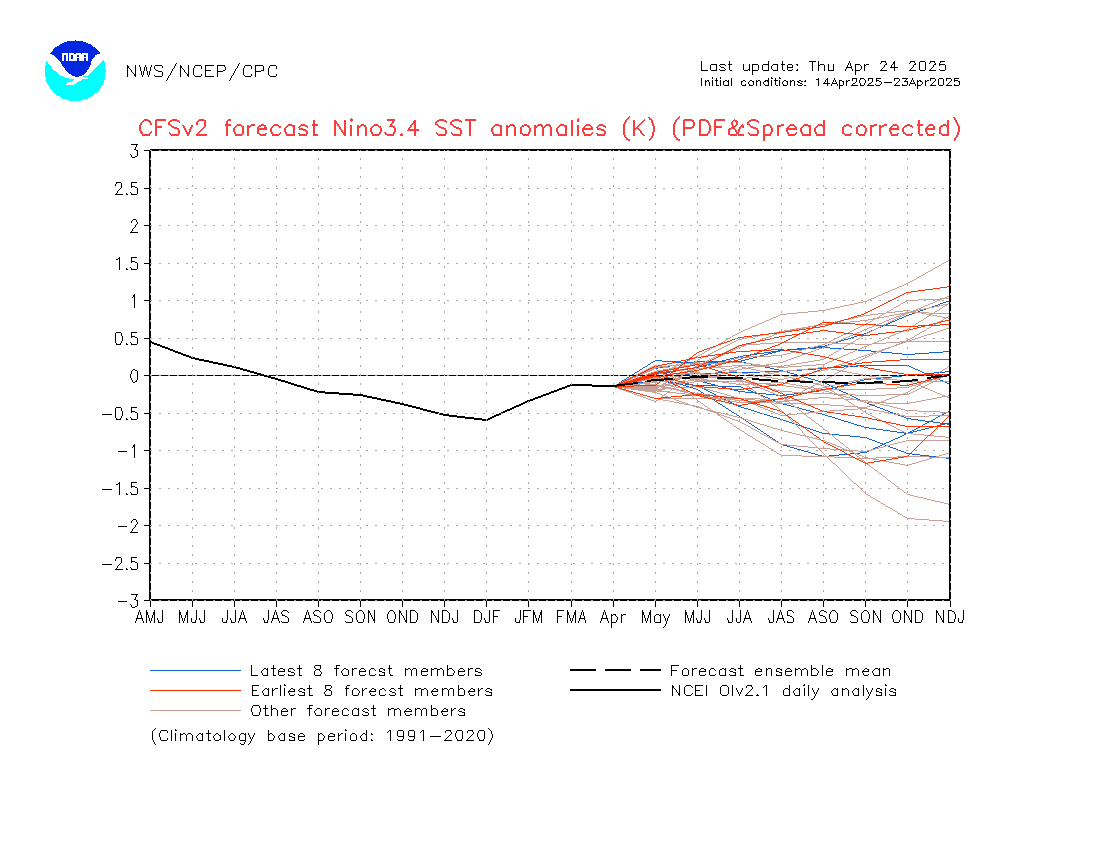Lightly edited at 5:54 p.m. EDT Saturday, May 27, 2023 mostly to compare the new to the prior Seasonal Outlook. They are very similar.
On the third Thursday of the month right on schedule NOAA issued what I describe as their Four-Season Outlook. The information released also included the Mid-Month Outlook for the single month of June plus the weather and drought outlook for the next three months. I present (apologies for the delay) the information issued and try to add context to it. It is quite a challenge for NOAA to address the subsequent month, the subsequent three-month period as well as successive three-month periods for a year or a bit more.
It is very useful to read the excellent discussion that NOAA issues with this Seasonal Outlook. In general, the overall level of confidence in the Seasonal Outlook is lower than usual for many reasons that are addressed in the NOAA discussion. It is best to read the full discussion but here are some of the highlights:
- Equatorial SSTs are near-to-above average across most of the Pacific Ocean and atmospheric conditions reflect ENSO-neutral conditions [Editor’s Note: The Atmosphere has not yet responded to the warming in the Eastern Pacific which is marginally at El Nino levels].
- At least a weak El Niño is likely given high levels of above-average oceanic heat content, but the range of possibilities include an 80 percent chance of at least a moderate El Niño and a 55 percent chance of a strong El Niño by the end of the year.
- This likely warm start to June along with monthly dynamical and statistical tools support increased probabilities for above-normal temperatures from the Pacific Northwest east to the Northern Great Plains.
- The NMME along with an increased potential for an early season TC [tropical cyclone] to emerge from the western Caribbean Sea favors above-normal precipitation [in June] for parts of the Southeast.
- The JJA 2023 temperature outlook favors above-normal temperatures over the western CONUS, the Southwest, the Gulf States, along the eastern seaboard, and for much of the state of Alaska.
- The JJA 2023 precipitation outlook depicts below-normal precipitation probabilities over the Pacific Northwest and parts of the Northern Rockies, the Southwest, and south coast of Alaska. NMME and C3S are in good agreement on below normal precipitation over the southwest and wet soil moisture over the Four Corners region may provide a sluggish start to the Monsoon this summer. Above normal precipitation probabilities are indicated over parts of the Middle and Lower Mississippi Valleys, the Ohio and Tennessee Valleys, the Southeast, and mid-Atlantic. Parts of the Central Plains tend to be anti-correlated with the monsoon region, and as such a weak tilt toward above normal precipitation is indicated.
- Confidence decreases in September-November (SON) 2023 and following seasons as lead time increases and dynamical models become more uncertain, however, El Niño is expected to become more dominant in the forecast(s), and the pattern begins to reflect El Niño conditions during fall and winter seasons.
- Decadal [Temperature] trends become the dominant player in spring and summer 2024, with below normal trends over the Pacific Northwest and above-normal trends over the Mid-Atlantic.

| The current weather report is always available at econcurrents.com To return to this article, hit the return arrow in the upper left-hand corner of your screen. |
Let’s Take a Look at the Mid-Month Outlook for June.
Combination Mid-Month Outlook for June and the Three-Month Outlook
The top row is what is now called the Mid-Month Outlook for June which will be updated at the end of May. There is a temperature map and a precipitation map. The second row is a three-month outlook that includes June. I think the outlook maps are self-explanatory. What is important to remember is that they show deviations from the current definition of normal which is the period 1991 through 2020. So this is not a forecast of the absolute value of temperature or precipitation but the change from what is defined as normal or to use the technical term “climatology”.
| Notice that the June and three-month outlooks are quite different. |
| For both temperature and precipitation, if you assume the colors in the maps are assigned correctly, it is a simple algebra equation to solve the month two/three anomaly probability for a given location = (3XThree-Month Probability – Month One Probability)/2*. So you can derive the month two/three outlook this way. You can do that calculation easily for where you live or for the entire map. |
Here are larger versions of the Temperature and Precipitation outlook maps for the single month of June
The maps are pretty clear in terms of the outlook.
And here are large versions of the three-month JJA 2023 Outlook
First temperature followed by precipitation.
The maps are larger versions of what was shown in the first graphic that had smaller versions of all four of these maps.
Drought Outlook
| The yellow is the bad news and there is hardly any yellow showing. The area with drought improvement is quite large. |
Short CPC Drought Discussion
Latest Seasonal Assessment –
Based on the U.S. Drought Monitor, drought coverage across the contiguous U.S. (CONUS) peaked at nearly 63 percent during late October 2022. Since that time, drought coverage and intensity have steadily decreased, especially across much of the West, the northern Great Plains, the Midwest, and the Tennessee and Ohio Valleys. As of early May, drought currently covers around 23 percent of the CONUS. In particular, an extremely wet winter reduced or eliminated drought across a large majority of California. Drought coverage there went from over 99 percent in early December 2022 to less than 6 percent currently. Over the past month, the pace of drought improvement has slowed significantly, but areas of improvement were noted in the northern Intermountain West, the central and northern High Plains, the central and northern Great Plains, southern Louisiana, and the areas of from Florida to southern New England. Meanwhile, the only broad area of deterioration covered a swath across central Missouri.
For June-July-August (JJA), outlooks favor below-normal precipitation over the northwestern CONUS, and the season usually brings only light precipitation at best along the western tier of the CONUS; therefore, persistence is expected in these areas, but the dry climatology will prevent significant changes in long-term precipitation and therefore preclude substantial drought expansion. Persistence is also expected in the northern Rockies from western Wyoming through the moderate drought in central Montana. The outlook is less certain in the Great Basin and surrounding areas, but expected surplus precipitation over the next few weeks is expected to leave improved conditions from southern Nevada into central Utah by the end of August. Farther east, the odds favor subnormal JJA precipitation in the southern High Plains and adjacent southern Rockies, prompting a persistence forecast for northwestern New Mexico and most locations in eastern New Mexico and adjacent Texas. There are enhanced chances for below-normal precipitation in northeastern New Mexico and parts of the drought area in Colorado, but heavy precipitation is anticipated through the end of May, and climatology is expected to keep conditions damp enough to leave improved conditions here at the end of August. Improvement or removal of drought is expected over the central and northern Plains because JJA is one of the wettest times of the year, and there are no compelling indicators pointing toward any significant periods of subnormal precipitation. Drought coverage is much lower from the Middle Mississippi Valley to the Atlantic Coast, but odds favor above-normal precipitation in most drought areas — Florida in particular — so drought removal is anticipated in these areas. Outside the CONUS, there are slightly enhanced chances for improved conditions across western Puerto Rico, but odds favor below-normal precipitation statewide across Hawaii, causing persisting or worsening drought conditions in the northern Big Island, and significant areas of drought development across leeward areas of all major islands.
Looking out Four Seasons.
Twelve Temperature Maps. These are overlapping three-month maps (larger versions of these and other maps can be accessed HERE)
Notice that this presentation starts with July/August/September 2023 (JAS since JJA is considered the near-term and is covered earlier in the presentation. The changes over time are generally discussed in the discussion but you can see the changes easier in the maps.
Comparing the new outlook with the prior Outlook,
The 12 temperature maps issued last month.
I have been showing the current set of outlooks with the prior set side by side. But I think the images are too small for most to be able to work with. I do the analysis so you do not need to but if you choose to do so the best way is to print out both maps. If you have a color printer that is great but not needed. What I do is number the images from last month 1 – 12 starting with “1” and going left to right and then dropping down one row. Then for the new set of images, I number them 2 – 13. That is because one image from last month in the upper left is now discarded and a new image on the lower right is added. Once you get used to it, it is not difficult. In theory, the changes are discussed in the NOAA discussion but I usually find more changes. It is not necessarily important. I try to identify the changes but believe it would make this article overly long to enumerate them. The information is here for anyone who wishes to examine the changes. I comment below on some of the changes from the prior report by NOAA and important changes over time in the pattern.
| The only major change I saw was in the NDJ 2023/2024 Temperature Outlook. It is an interesting change in where it will not be warmer than climatology. It seems to be moving the change in the pattern one month earlier. The pattern makes a major change in MAM 2024. This seems to be where NOAA has switched over to statistical models. I will be paying attention to that transition with next month’s NOAA report. |
Now the Twelve New Precipitation Maps
Similar to Temperature in terms of the organization of the twelve overlapping three-month outlooks.
Comparing the new outlook with the prior Outlook,
The maps that were released last month.
A good approach for doing this comparison is provided with the temperature discussion.
| I do not really see any major changes this month compared to last month. The pattern seems to be pretty similar throughout the twelve maps shown. This is very surprising to me. When I say pretty similar I do not mean identical. |
NOAA Discussion
Maps tell a story but to really understand what is going you need to read the discussion. I combine the 30-day discussion with the long-term discussion and rearrange it a bit and add a few additional titles (where they are not all caps the titles are my additions). Readers may also wish to take a look at the article we published last week on the NOAA ENSO forecast. That can be accessed here.
I will use bold type to highlight some things that are especially important. My comments, if any, are enclosed in brackets [ ].
CURRENT ATMOSPHERIC AND OCEANIC CONDITIONS
Equatorial SSTs are near-to-above average across most of the Pacific Ocean and atmospheric conditions reflect ENSO-neutral conditions. Since early April 2023, near-to-above average SSTs have persisted across most of the tropical Pacific Ocean, and eastern Pacific positive SSTs have expanded westward to the east-central Pacific ocean. Weekly SST departures remain largest in the NINO1+2 region reaching 2.4 degrees Celsius above normal, while the NINO3.4 region has reached 0.5 degrees Celsius above normal. Subsurface temperature anomalies became positive in February and have increased through mid-April, and positive subsurface temperature anomalies now dominate the equatorial Pacific Ocean. During the last 30 days, weak suppressed convection was observed near the equator over Indonesia, and low-level winds were near average across most of the equatorial Pacific Ocean, reflecting ENSO-neutral conditions.
The Madden Julian Oscillation (MJO) has remained active, and the enhanced phase propagated eastward from the Maritime Continent into the western Pacific during the past week. The Realtime Multivariate MJO (RMM) index for early April 2023 through mid-May 2023 indicates that the MJO signal completed another global circumnavigation, however the MJO recently decreased in amplitude over the western Pacific due to destructively interfering Kelvin and Rossby Wave activity. RMM forecasts show the MJO regaining amplitude over the western Pacific at a slow phase speed in the upcoming week and propagating slowly across the western Pacific through late May. In RMM forecasts, some ensemble members from the Global Ensemble Forecast System version 12 (GEFSv12) and the European Centre for Medium-Range Weather Forecast (ECMWF) model forecast continuation of the MJO into the end of May, but the ensemble mean ECMWF indicates that MJO activity may wane.
PROGNOSTIC DISCUSSION OF SST FORECASTS
The latest Probabilistic ENSO Outlook issued in May 2023 favors a transition from ENSO-neutral to El Niño during May-July (MJJ) 2023, with chances of El Niño increasing to greater than 90% into winter 2023-24, and an El Niño Watch is in effect. The most recent plume from the International Research Institute (IRI) also indicates likely formation of El Niño in the May to July seasons and persistence into the winter. At least a weak El Niño is likely given high levels of above-average oceanic heat content, but the range of possibilities include an 80 percent chance of at least a moderate El Niño and a 55 percent chance of a strong El Niño by the end of the year. Dynamical model forecasts from the North American Multi Model Ensemble (NMME) and the Climate Forecast System model version 2 (CFSv2) favor a moderate to strong El Niño through November-January (NDJ) 2024 while they are available, and forecasts become more uncertain in spring and summer 2024 based on statistical models.
30-DAY OUTLOOK DISCUSSION FOR JUNE 2023
The June 2023 temperature and precipitation outlooks are based on the Climate Forecast System Model version 2 (CFSv2), North American Multi-Model Ensemble (NMME) and Copernicus model (C3S) suites for June, the week 3-4 model solutions, statistical tools, and soil moisture conditions. The Madden-Julian Oscillation (MJO) remains active with its enhanced phase over the west-central Pacific. The MJO influence on the mid-latitude circulation pattern and associated temperatures diminishes by late spring. However, it can modulate tropical cyclone (TC) development across the East Pacific and Atlantic basins. If the MJO continues to propagate eastward over the Western Hemisphere through late May into early June, that would provide a favorable large-scale environment for the genesis of an early season TC in the western Caribbean Sea. This was a factor in the June precipitation outlook for the Southeast. Since a transition from El Niño Southern Oscillation (ENSO)-neutral to El Niño is likely during the next couple of months, El Niño temperature and precipitation composites during May-June-July were also considered.
Temperature
A strong omega block has persisted over or in the vicinity of North America since late April. Model solutions depict a weakening of this blocking pattern during late May which lowers forecast confidence heading into June. During late May and early June, the Global Ensemble Forecast System (GEFS) and European Centre for Medium Range Weather Forecast (ECMWF) ensemble means maintain positive 500-hPa height anomalies over Alaska and the northern two-thirds of the contiguous U.S. (CONUS) with near to below normal heights across the southern tier. The prominent area of positive 500-hPa height anomalies at the middle to high latitudes of North America would favor a warm start to June throughout the northern CONUS. This likely warm start to June along with monthly dynamical and statistical tools support increased probabilities for above-normal temperatures from the Pacific Northwest east to the Northern Great Plains. This favored area of above-normal temperatures extends southward to the Central Great Plains and Middle Mississippi Valley where low soil moisture conditions are likely to warm surface temperatures. The week 3-4 GEFS and ECMWF models, C3S model, and recent daily CFSv2 model runs for June support to increased probabilities for above-normal temperatures across parts of the Northeast. Based on the NMME, C3S, and decadal trends , above-normal temperatures are favored for parts of the Southwest, Rio Grande Valley, Gulf Coast, and Florida. Increased probabilities for above-normal temperatures are forecast for nearly all of Alaska, consistent with dynamical and statistical tools. The one exception is the western coast of Alaska due to below-normal SST anomalies across the eastern Bering Sea.
Precipitation
The week 3-4 GEFS and ECMWF, valid during early to mid-June, are in good agreement for elevated probabilities of above-normal precipitation across portions of the High Plains, Central Rockies, and Great Basin. This wet signal is also present in the monthly NMME and consistent among daily CFSv2 model runs for June. Therefore, above-normal precipitation is favored for those areas during June. The NMME along with an increased potential for an early season TC to emerge from the western Caribbean Sea favors above-normal precipitation for parts of the Southeast. Based on the NMME and El Niño precipitation composites, elevated probabilities for below-normal precipitation are forecast for southeastern Alaska and parts of the Pacific Northwest. A large area of EC was necessary in the June precipitation outlook due to weak or conflicting signals among the guidance and lower predictability associated with convective rainfall during the late spring and early summer. This large coverage of EC will be reevaluated with the updated June outlook, released on May 31.
SUMMARY OF THE OUTLOOK FOR NON-TECHNICAL USERS (Focus or June through August)
El Niño Southern Oscillation (ENSO) neutral conditions are currently observed, and equatorial sea surface temperatures are near-to-above average across most of the Pacific Ocean. An El Niño watch is in effect as a transition from ENSO-neutral to El Niño is favored during May-July 2023, with chances of El Niño increasing to greater than 90% in winter 2023-2024.
Temperature
The June-July-August (JJA) 2023 temperature outlook favors above normal temperatures over the western contiguous United States (CONUS), the southwest, southeast, and along the eastern seaboard to New England. A tilt toward warmer than normal temperatures is also favored over most of Alaska. The largest probabilities of above normal temperatures (60 to 70 percent) are forecast over the Southwest, and probabilities reach 50 to 60 percent along the coast from Texas to New England.
Precipitation
The JJA precipitation outlook favors below normal precipitation probabilities over the Pacific Northwest, Southwest, and south coast of Alaska. Above normal precipitation probabilities are more likely for the eastern CONUS, including the Southeast, Mid-Atlantic, Lower and Middle Mississippi Valley. The North Slope of Alaska also tilts weakly above normal. Equal chances (EC) are forecast for areas where probabilities for each category of seasonal mean temperatures and seasonal accumulated precipitation amounts are expected to be similar to climatological probabilities.
BASIS AND SUMMARY OF THE CURRENT LONG-LEAD OUTLOOKS
PROGNOSTIC TOOLS USED FOR U.S. TEMPERATURE AND PRECIPITATION OUTLOOKS
Dynamical model forecasts from the NMME, CFSv2, and Copernicus (C3S) multi-model ensemble systems are used for the first six leads when they are available as was the objective, historical skill weighted consolidation, that combines both dynamical and statistical forecast tools. The Calibration, Bridging and Merging (CBaM) tool anchored to the NMME forecasts and “bridged” to the Niño3.4 index is also significantly utilized. El Niño impacts were considered given the elevated probability of transition to El Niño during MJJ 2023, and El Niño composites and correlation/regression of temperature and precipitation with the NINO3.4 region were used to determine typical El Niño impacts. Statistical guidance such as the global SST based Constructed Analog (CA) and long term temperature and precipitation trends played a role in many of the outlook seasons, particularly beyond lead 6 when dynamical model guidance is unavailable. Antecedent soil moisture conditions and coastal SSTs are considered at early leads.
PROGNOSTIC DISCUSSION OF OUTLOOKS – JJA 2023 TO JJA 2024
TEMPERATURE
The JJA 2023 temperature outlook favors above normal temperatures over the western CONUS, the Southwest, the Gulf States, along the eastern seaboard, and for much of the state of Alaska. The highest probabilities of above normal temperatures (60 to 70 percent) are over parts of the Southwest, Southern Rockies, and western Southern Plains where NMME and C3S show consistent strong probabilities of above normal temperatures, soil moisture is anomalously dry, decadal temperature trend is above normal, and where precipitation is forecast to tilt toward below normal for this season. 50 to 60 percent probabilities are indicated from the Southwest along the coast to New England where there was strong model agreement as well as support from above normal decadal temperature trends and above normal coastal SSTs. A weak tilt toward above normal temperatures (33 to 40 percent) is forecast over California owing to weaker temperature signals in NMME and C3S, likely related to recent coastal SST anomalies that leaned below normal and recently transitioned to neutral. A weak tilt toward above normal temperatures is also indicated over western Oregon and Washington given a slight weakness in dynamical models as well as mixed month to month temperature teleconnection to El Niño as it evolves through JJA. EC of above, near, and below normal temperatures are depicted over parts of the Northern Plains to the Great Lakes and parts of the Ohio River Valley were tools where weak or had inconsistent signals , and given currently neutral Great Lakes temperatures. Over Alaska, NMME, C3S, CFSv2, and CBaM all favor a tilt toward above normal temperatures over the southern half of the state, consistent with expected ENSO teleconnection in JJA, while statistical tools indicate EC over northern parts of the state and a spatially small, very weak tilt toward below normal decadal trend. Anomalously cold SSTs along the southwestern coast of Alaska led to a moderation of probabilities over the southwest part of the state.
For the remainder of the summer and into early fall (July-September, JAS through August-October, ASO), 50 to 60 percent probabilities of above normal temperatures are maintained over the western CONUS and stretching along the eastern seaboard where agreement remains among dynamical and statistical tools, and due to strong probabilities in the objective skill-based consolidation. Probabilities over Alaska also remain above normal with the largest probabilities over the southern half of the state where there is dynamical and statistical model agreement. Compared to last month’s JAS and ASO forecasts, probabilities are slightly increased over the Ohio and Tennessee Valley regions and along the coast given strong probabilities in CBaM, NMME, and CFSv2 and where the objective skill based consolidation had higher probabilities. EC is maintained over the central CONUS where signals were weak, though the eastern Great Lakes tilt above normal consistent with dynamical models .
Confidence decreases in September-November (SON) 2023 and following seasons as lead time increases and dynamical models become more uncertain, however, El Niño is expected to become more dominant in the forecast(s), and the pattern begins to reflect El Niño conditions during fall and winter seasons. Above normal temperatures are favored over the western and eastern CONUS, with highest probabilities reaching 50 to 60 percent over New England where decadal trends are strong. EC is indicated over parts of the central CONUS in SON and October-December (OND) given lack of consistent signal in tools. By fall and winter 2023-2024 (November through January, NDJ and December through February, DJF) we expect to begin seeing a canonical El Niño pattern of increased temperatures over the Northern Tier and a reduction of probabilities over the southern CONUS. Warmer than normal temperatures are generally favored over Alaska in the fall and winter months. Forecasts for spring and summer 2024 are more reliant on decadal trends given the comparatively uncertain forecast of El Niño and lack of dynamical model data at longer leads, though probabilities are higher where decadal trends and constructed analogues based on SSTs agree. February through April (FMA) 2024 has elevated probabilities of above normal temperatures over Alaska and the east coast, with probabilities over CONUS expanding westward in April through June (AMJ) and JJA 2024.
PRECIPITATION
The JJA 2023 precipitation outlook depicts below normal precipitation probabilities over the Pacific Northwest and parts of the Northern Rockies, the Southwest, and south coast of Alaska. The tilt toward below normal precipitation over the Pacific Northwest and south coast of Alaska is consistent with expected El Niño teleconnections as well as below normal decadal trends . NMME and C3S are in good agreement on below normal precipitation over the southwest and wet soil moisture over the Four Corners region may provide a sluggish start to the Monsoon this summer. Above normal precipitation probabilities are indicated over parts of the Middle and Lower Mississippi Valleys, the Ohio and Tennessee Valleys, the Southeast, and mid-Atlantic. Parts of the Central Plains tend to be anti-correlated with the monsoon region, and as such a weak tilt toward above normal precipitation is indicated. The remainder of the above normal region is due to enhanced probabilities in C3S and above normal decadal trends with the highest probabilities aligned with where decadal precipitation trends are strongest as well as recent high rainfall amounts. Though above normal precipitation probability is favored over the northern part of Alaska owing to weak decadal trends and above normal probabilities in CFSv2, probabilities are weak and EC is indicated for the central parts of Alaska given inconsistent signals and significant changes from last month’s forecast to this month’s. The dry signal over the Southwest is maintained through JAS 2023 as dynamical models agree on below normal probabilities. The above normal precipitation over the eastern CONUS shifts westward in JAS 2023 owing to a reduction of probabilities over the southeast in the forecast consolidation. Above normal precipitation is maintained over Northern Alaska through JAS and into winter 2023 as dynamical models generally forecast above normal precipitation. Over the Pacific Northwest, a weak tilt toward below normal precipitation is favored through FMA2024 consistent with decadal trends and constructed analogues based on SSTs. Above normal precipitation is favored for the Southeast and Gulf States owing to canonical El Niño teleconnection during the winter months. Below normal precipitation is depicted over the north Central Plains and Great Lakes during the winter, also consistent with El Niño. Decadal trends become the dominant player in spring and summer 2024, with below normal trends over the Pacific Northwest and above normal trends over the Mid-Atlantic. Confidence decreases over Alaska in spring and summer 2024, with only a weak tilt toward above normal rainfall in March through May (MAM) 2024 over the northwest consistent with above normal precipitation trend, and EC indicated for the remaining leads given lack of clear signal.
Review of the ENSO Assumptions utilized by NOAA (CPC) in Preparing this Four-Season Outlook
It is useful to review the ENSO forecasts used by NOAA to produce this Four-Season Outlook. We reported on that last week and you can read that article by clicking HERE
The key information used by NOAA follows.
IRI CPC ENSO STATE Probability Distribution (IRI stands for the International Research Institute for Climate and Society)
Here are the new forecast probabilities. This information is released twice a month and the first release is based on a survey of Meteorologists, the second is based on model results. The probabilities are for three-month periods e.g. MAM stands for March/April/May. I am just showing the first release which is what we have and presumably what NOAA (actually their CPC Division) worked from.
| It is too early to be certain but it sure looks like we are headed into an El Nino. |
Tropical Subsurface Temperature Anomalies
| You can update this graphic by clicking HERE and scrolling down to “Mean and anomalous equatorial temperatures“. One has to differentiate between the surface and at depth. The surface still fits with ENSO Neutral but below the surface, there is a lot of anomalously warm water. That is why this looks like a sustainable El Nino. |
| The image will update if you click HERE. https://www.cpc.ncep.noaa.gov/products/people/wwang/cfsv2fcst/images3/nino34SeaadjPDFSPRDC.gif It is pretty bullish about a strong El Nino arriving pretty soon. |
Resources
The link for the drought outlook map and some discussions that come with the map can be found by clicking HERE.
| I hope you found this article useful and interesting. |
